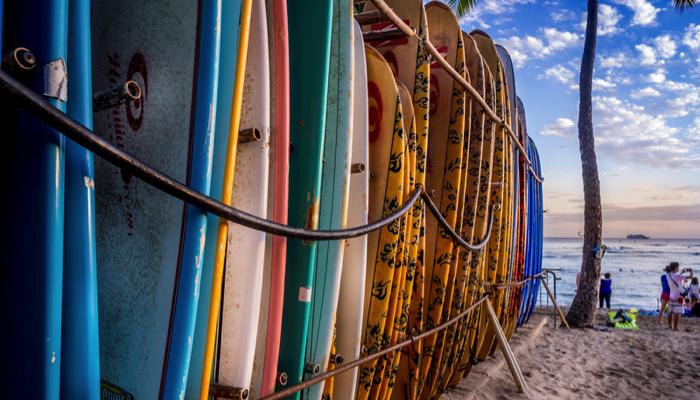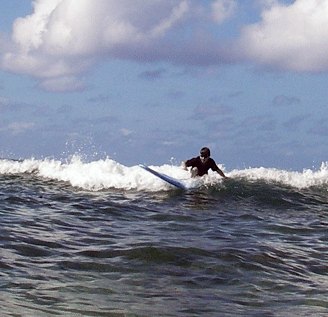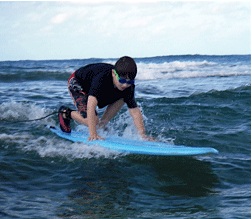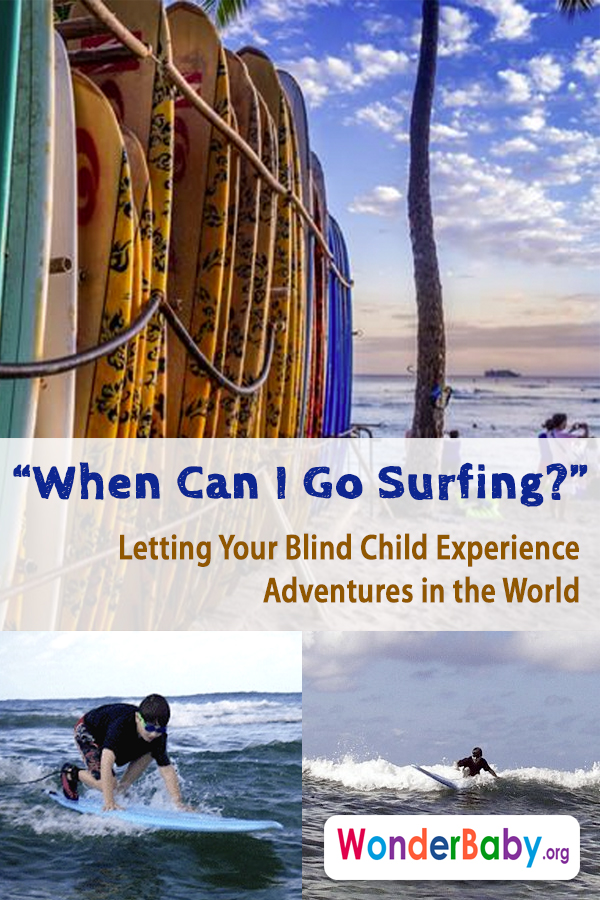“So Dad, When Can I Go Surfing?” Letting Your Blind Child Experience Adventures in the World

By Eric Vasiliauskas
This article first appeared in the Vol. 26 2007 issue of Future Reflections. To subscribe to Future Relfections, Click Here.
Young children, whether sighted or blind, share an innate curiosity to learn about the world. This is why they constantly ask questions and want to do this or try that. While it is particularly important to create an atmosphere that actively encourages and supports a blind child’s desire to explore, sometimes such quests for new experiences can catch you off guard. This is how one such request played out.
Several summers ago, I was invited to lecture at a medical conference in Hawai’i. My wife and two boys, Vejas and Petras, accompanied me. Disney’s Hawai’i-based cartoon movie “Lilo & Stitch” débuted that very week. I was not particularly surprised when, after listening to the Read-A-Long audio book version of “Lilo & Stitch,” my ever-inquisitive, soon-to-be first grader asked, “Dad, what exactly is surfing?”
As we continued to drive, I did my best to explain. Vejas was already very familiar with kickboards. Before the trip we had already discussed that a boogie board was in a sense a bigger version of a kickboard that you lie down on to ride a wave. I further built on these concepts and elaborated that a surfboard was sort of similar to a boogie board, but much longer and that rather than lying on it, you actually stand up on the board to ride the wave.
Since I knew where this line of conversation was likely to lead, I decided to preemptively divert the discussion by enthusiastically reassuring him that we would go boogie-boarding later that week and that the activity would give him a sense of what surfing is. I could tell that this parental diversionary tactic was only partially successful; I’m convinced that that is when Vejas first started to dream of surfing.
A vacation in Hawai’i could hardly be considered complete without attending a luau. As part of the pre-dinner festivities, in addition to exhibits featuring hula dancing, Hawaiian instruments, and local arts and crafts, there was one devoted to surfing. Vejas had never actually laid his hands (or feet for that matter) on a surfboard, so once the crowd around the exhibit thinned out a bit we walked over to meet the young local surfer in charge of the display.
Vejas in his usual fashion struck up a conversation and asked a barrage of questions about surfing. As Vejas then climbed onto one of the surfboards, I started to make wave sounds and to move the board around in an attempt to simulate the motion of waves, so as to give him a sense of what it might feel like to surf. He was visibly intrigued and excited.
My then five-and-one-half-year-old enthusiastically seized this opportunity to ask, “So Dad, when can I go surfing?” I did what I imagine many parents of a recent kindergarten graduate might do in this situation and decided I would try to “punt” this one for a while by rationalizing that as we were near the end of our trip, we would try surfing “the next time we go to Hawai’i.” As a compromise I proposed that we not only go boogie boarding the next day, but sea-kayaking as well.
We in fact had a great time the following morning. We rented a two-person sea-kayak. Vejas sat in front wearing his life jacket and I sat behind him. As we paddled out into the calm bay we discussed water safety and I shared some stories from my younger days as a lifeguard. Towards the end of our adventure, a rogue wave snuck up on us from behind. Fortunately, I noticed it just in time to yell to Vejas to brace himself and hold on as tight as he could. As my adrenaline surged, I leaned into my paddle with all my might. The wave literally lifted and carried us forward as it proceeded toward the shore. We essentially surfed the wave in our kayak and to this day I am amazed that we actually managed to remain upright.
As we recovered from the excitement, I explained to Vejas how we would have handled the situation had we gone for a major tumble. It occurred to me that this was a perfect opportunity for a real life lesson. Thus, after conferring with Vejas, once we reached the shallow water near the beach, we together tipped the kayak over—on purpose. I then showed him how to right the kayak and how to pull himself out of the water and climb back in. Vejas got such a kick out of this, that upon his request we repeated this maneuver over a number of times.
Next we went boogie boarding. Only adult-sized boards were available for rent and it soon became evident that Vejas was not long enough to be able to effectively kick or to really stabilize the board, nor could he adequately anticipate the bigger waves in this part of the bay. We discovered that if he lay on top of the board and I positioned myself directly over him, I could kick with my fins and make sure we caught the waves. This way we were able to ride bigger waves together. We caught some great waves and had our fair share of spills as well. Vejas beamed radiantly as he relayed the morning’s adventures to his mother and little brother that afternoon. Yet while boogie boarding was lots of fun, Vejas knew it was not the same as surfing.

Well, as fate would have it, we decided to go on a real two-week vacation (no work this time) to Kaua’i the following summer. As soon as the airplane’s wheels lifted off the ground Vejas stopped reading the book his mother had Brailled for him for the flight. He turned his head towards me and in a very focused fashion extended his hand to find my face and gently guided it in his direction with the clear intent of making sure he had my full attention. (I wonder where he learned that maneuver?) He then pointedly posed his question, a question that undoubtedly had been brewing ever since we began to plan this trip: “So Dad, when are we going surfing?” I reassured him that we would look into it once we got to Hawai’i.
About a week into the trip, Vejas again asked, “So Dad, which day is my surfing lesson?” I realized at that point that there was no getting around it. That evening I looked through the multitude of brochures and visitors’ guides we had accumulated and saw a promising ad for lessons by a local world-renowned champion surfer.
Rasa and I both believe that our children should have the same types of experiences as other children. By this time we had met or heard of many remarkable blind individuals and of their accomplishments. We had thus already come to understand and fully believe that there is virtually nothing a blind person can’t do if they put their mind to it. Inspired by Cara Dunne-Yates and her family, I had even taken Vejas skiing with me when he was three years old. Yet as I dialed the number listed in the advertisement, I began to imagine what the person answering the phone would think. Not only was I asking for surfing lessons for a six-year-old, but a blind one to boot. To my pleasant surprise, the lady who answered the phone with a friendly “aloha” took this all in stride. She called me back within the hour and informed me she had arranged for a private surf lesson.
Several mornings later, we woke up very early and drove forty-five minutes to Poipu Beach, where at seven a.m. we met Vejas’s surf instructor, Miguel. He had grown up in Hawai’i and had started surfing at such a young age that he didn’t remember how old he was when his father first put him on a surfboard. Miguel had been on the professional surfing circuit for a number of years. He had a nine-year-old son who he had taught to surf at three years of age on this very beach. He did not seem even a little bit phased by the blindness issue. He asked appropriate questions in a tactful way. He wanted to know how strong a swimmer Vejas was and was pleased to learn he had been taking formal swimming lessons weekly since three-and-one-half years of age. He asked if Vejas had enough residual vision to distinguish the water, the sand, or the surfboard. Vejas informed him that he could only see light.
They first practiced on land for half an hour. Miguel had Vejas explore the entire surfboard. He explained that the front of the surfboard is termed the nose while the back end is called the tail. Vejas learned that the sides, or the rails, are particularly important, as that is where all the balance is. The deck is the part you ultimately stand on.
They went over the dynamics of positioning on the board. He had Vejas lie on the surfboard with his hands holding onto the rails and his toes pointed towards the tail. He then had Vejas start out in paddle position and pretend to catch a wave. Miguel described how, as Vejas first engaged the wave, he would need to position his arms in push-up position and then pop up into surf stance. (I must admit that it was refreshing for me to hear an outside person emphasize the importance of body posture and head positioning.) Then like a drill sergeant of sorts, the instructor had Vejas practice by verbally and tactilely guiding him through the motions of springing up and assuming the proper surfing stance over and over and over again until this kinesthetically was integrated to the point it was nearly automatic.
Miguel then looked at me and announced that it was time to graduate and move the lesson to the ocean. He chose a spot in the coral reef where the waves gently rolled in. Miguel instructed me to wait in the shallow water by the shore to catch Vejas when he arrived. I watched as they headed out to the water and I prepared my camera. In the distance, Miguel then guided the surfboard around so that it pointed towards the shore.

When the right wave finally came along, Miguel gently pushed the surfboard forward. From there the wave and Vejas took over. On his very first run Vejas pushed up, then moved his back foot into position, followed by his lead foot. His legs were appropriately bent and his head looked forward as he assumed a near perfect surf stance.
I am somewhat embarrassed to admit that I was not fully prepared for what followed. I was in fact so mesmerized and blown away that not only did I forget I had a camera, I literally watched Vejas surf right past me. As I cheered him on, I forgot that I was supposed to catch him. I was suddenly shaken from my trance when a few seconds later the nose of his board lodged into a sandbar and Vejas unexpectedly lunged forward off the board. Ouch!
I rushed over to him, not quite sure what to expect. Before I could ask him how he was, he exclaimed: “Did you see me Dad? I want to do that again!” You should have seen the joy on his face and the beaming sense of accomplishment that radiated from him after catching his first wave, standing up, and riding the wave all the way to the shore. He was, as we say in California, “totally stoked!” It was a storybook-perfect first run. He surfed for another hour that morning taking his fair share of spills and wipeouts amongst the better runs.
I too was beaming with fatherly pride the rest of the lesson and have to admit that it was fun to watch the smiles on the faces of passers-by out for an early morning stroll on the beach, amused as they saw this six-and-one-half-year-old kid realize one of his dreams and enthusiastically persist despite the spills. I kept imagining what they would be thinking if they knew that this determined youngster was blind as well.
Talk about a self-confidence building experience! Vejas’s accomplishment commanded an immediate sense of respect from his peers.
During parent orientation night a few weeks later, the teacher had allotted me five minutes to talk about Vejas and blindness as it related to his first grade class. I explained how for Vejas to successfully compete in life he would ultimately be held to the same standards as his sighted peers and thus it was crucial that he learn to be independent and to do things on his own. I had prepared a brief handout for the parents that included child-oriented Web sites about blindness, pictures and descriptions of some remarkable blind individuals, activities Vejas enjoyed, and suggestions on how parent-volunteers and classmates could facilitate our son’s socialization as well as promote his independence in the classroom and during extracurricular activities.
The pictures of Vejas’s summer activities were by far the most powerful part of the handout. We included these in our parent’s portion of his IEP document as well. In a way that written and verbal description could not quite do justice, the pictures of our blind six-year-old surfing immediately challenged the established paradigms of the parents, teachers, and other school staff, and even VI professionals. Preconceived notions of what a blind child is capable of began to melt away. The minds of those that would be interacting with our son were opened, allowing them to see him as a capable adventurous boy who is eager to take on life’s experiences.
It was during that same vacation that Rasa and I read the Future Reflections, Introductory Issue paperback for the first time. We read with great interest as blind adults, educators, parents of blind children, and even blind kids themselves shared experiences covering a wide variety of topics pertinent to growing up blind and to raising a blind child. Importantly, each was presented from a positive, uplifting, practical, and success-in-academics and success-in-life prospective. How refreshing and comforting it was to find such a concentration of viewpoints that paralleled and supported those we had come to develop!
One of the chapters in this introductory issue included the presentations of a panel of five blind youths who spoke at an NFB Convention on the topic of “Fun, Friends, and Fitting In.” The young panelists individually and collectively demonstrated that blind kids can do —and in fact do do —things that sighted kids do. They highlighted the importance of independence and stressed how actively working to enhance their blindness skills not only facilitated their independence, but also their self-confidence and socialization.
During the flight home I read each child’s speech to Vejas. He eagerly listened to every detail. Vejas was very excited by the “virtual encounters” with each of the young presenters who, like he, was blind and who shared many of his own interests. The profound impact that Adam, Brian, Jennifer, Noel, and Lauren had on my son soon became evident when afterwards he turned to me and excitedly and earnestly exclaimed, “so that’s why you want me to be more independent!” Indeed, these five young Federationists had managed to get across this message and ignite an internal desire to strive for increased independence in our son in a way that his teachers and we as sighted parents had not quite been able to do.
Next we read excerpts from an issue of the Braille Monitor about a large number of blind high school graduates and college students who had earned scholarships from the NFB. Even at this young age, Vejas was excited by the range of careers these success-oriented young men and women were choosing to pursue. As I watched, an amazing transformation began to take place in my son before my very eyes —a transformation sparked by the stories and ambitions of blind children and blind youth —I began to truly understand the potential power of the National Federation of the Blind.
Vejas is now ten years old and is the proud owner of his very own seven-foot yellow surfboard. He had a second lesson with Miguel a few years later and he has had several additional formal lessons with other surf instructors since then. I have to admit that Vejas looked like he was having so much fun out there on the waves, that he inspired me to take up surfing last year. I once asked Vejas which instructor he thought was the best. “Miguel,” he responded without much hesitation. When I asked him why, I was admittedly a little surprised by his insightful response: Vejas said it was because Miguel paid the most attention to detail and had the highest expectations of him.
Perhaps some of the biggest limitations the blind face are conceptual biases that most of us have grown up with. Unfortunately these misconceptions of the capabilities of the blind are relayed either directly or indirectly to our blind children even at a very young age by the adults and even children that they interact with. The NFB is devoted to changing what it means to be blind. I submit that accounts of the accomplishments of young Federationists may have the greatest potential to influence changes in perceptions of what it means to be a blind child. “Perceptual early intervention” via such peer-based stories has the potential to serve as seeds of inspiration of what is possible to other blind children, their parents, and teachers.
I thus urge more parents, children, teenagers, and young adults to take the time to write down and share your adventures and experiences to help develop a childhood-focused resource of what is possible. If enough of you do so, perhaps some day they may even evolve into a dedicated “Kids Corner” in Future Reflections or the Braille Monitor.
Read this article in Arabic: حيوا-السيدة-العمياء

Related Posts

Eye Conditions and Syndromes, Visual Impairment
Neuralink Announces Plans to Restore Sight to the Blind with Brain Chip
Elon Musk’s company Neuralink has announced plans to begin human trials of its new “Blindsight” brain chip by the end of 2025.

Visual Impairment
The Gift of Understanding: How a Young Child Helps His Blind Father Navigate Life
When a parent is blind, it’s natural for people to wonder how their sighted child will adapt. Will they struggle to understand their parent’s needs? Will they feel burdened by...

Braille and Literacy, Toys, Visual Impairment
24 Braille Toys for Kids Who are Blind
Everything from alphabet blocks to raised line coloring pages and activity books to puzzles to card and board games... and so much more! And it's all in braille ready for...